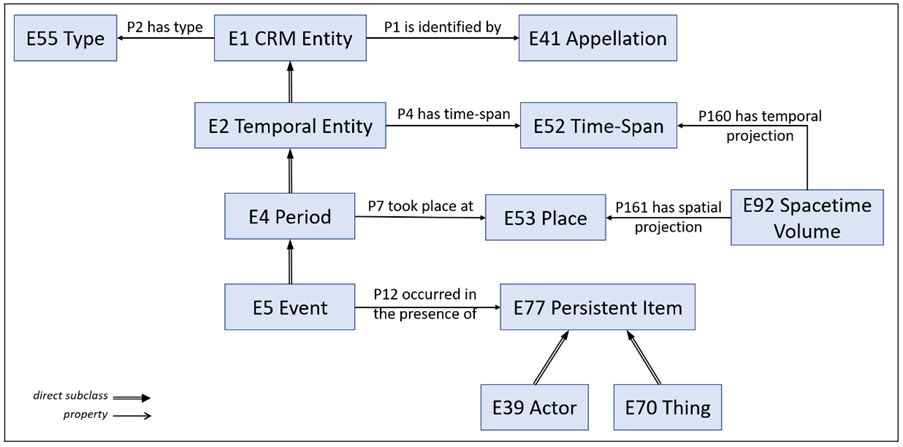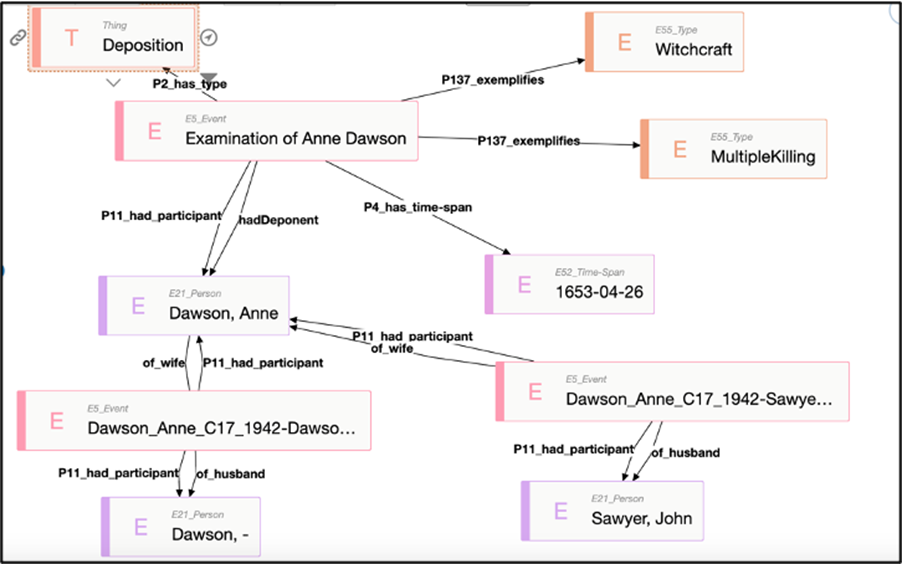Blog 6: Building the VOICES Knowledge Graph of Early-Modern Irish Women
A Knowledge Graph (KG) is a way of representing information as a network of entities, such as people, places, events, and concepts, and the relationships between them. Rather than storing data in flat tables, a KG uses a flexible structure of subject–predicate–object triples (e.g., “Jane Doe” — lives in — “Dublin”) to capture meaning and context. This makes it possible to link diverse pieces of information together, ask complex questions, and uncover patterns that might remain hidden in traditional databases.
The VOICES Knowledge Graph builds on the foundational infrastructure developed by the Virtual Record Treasury of Ireland[1] (VRTI) project which aims to digitally reconstruct archival collections lost in the 1922 destruction of the Public Record Office of Ireland (PROI). The VRTI Knowledge Graph for Irish History currently models over 10,000 notable Irish historical figures from the Dictionary of Irish Biography as well as a present-day geo-stack of Ireland. While the VRTI-KG has primarily modelled elite men, VOICES aims to model non-elite women documented in historical records such as the 1641 Depositions, the Irish Court of Chancery, Statute Staple Records and testamentary materials.
The KG uses the Resource Description Framework (RDF)[1] to represent data as triples. Data is uplifted from curated spreadsheets (CSV files) into RDF using R2RML[2], a W3C-recommended mapping language used for generating RDF from data stored in relational databases. Using the R2RML-F[3] extension these CSV files can be accessed as if they were relational databases. The R2RML mappings specify how the data contained in the spreadsheets are transformed into entities and relationships in line with the ontologies and vocabularies used in the KG.
At its core, the KG is grounded in the CIDOC Conceptual Reference Model[4] (CIDOC-CRM). CIDOC-CRM is a high-level, event-centric ontology used to represent relationships found in historical and cultural heritage data, enabling the structured description of people, events, objects, and the contexts that connect them (see Figure 1). VOICES extends CIDOC-CRM by introducing concepts specifically for modelling women, their roles in early modern Ireland and their experiences at this time, with a particular focus on their experiences of violence. The construction of this ontology is being driven by competency questions developed in collaboration with the project’s historians including:
- How many women worked as spinners, seamstresses, tanners, shopkeepers, labourers, wet nurses, midwives?
- What types of violence did women experience?
- Where did refugees find refuge, and in what numbers?
- How many women loaned/borrowed money, to/from whom, and for what purpose?
- How much land did women hold in [year]?
- What were the female landholdings in [place name]?
- How many women died during the 1640s, and how?

Figure 1: CIDOC-CRM
The first dataset to be uplifted to the KG was the 1641 Depositions a collection of witness statements collected by the authorities in the wake of the 1641 Rebellion in Ireland. These depositions contain valuable first-hand accounts from and about women, including references to violence, displacement, landholding, debt, and family structures. Information about female deponents and the depositions they participated in was curated into structured CSV files, following person and event schemas. The person schema, developed under the VRTI project, includes 53 fields grouped into categories such as:
- Names and aliases (normalised and variant spellings)
- Biographical dates and places
- Familial relationships
- Occupations and social status
- Links to external identifiers and references (e.g., Wikidata, DIB)
The deposition event schema captures information such as a the date of the deposition, whether violence and/or sexual violence was reported, and what material losses were reported.
The pilot VOICES KG contains:
- Over 65,000 RDF triples
- 959 female deponents
- 1,012 depositions
- 650 men (spouses of female deponents)
For example, Figure 2 shows the triples related to the deposition of Anne Dawson.

Figure 2: A screenshot of the triples describing a female deponent displayed using Ontodia[6], an out-of-the-box KG exploration tool
These are not simple database records. They are interlinked nodes in a dynamic web of data, enabling powerful questions like:
- Which women reported sexual violence?
- What occupations were women associated with across depositions?
- What compensation did women claim?
As the VOICES-KG grows, it will continue to integrate data from additional historical sources and support ever more detailed information on women’s roles in Irish history (see Figure 3 which demonstrates how Hester Lambart is linked to multiples historical sources). By combining historical insight, data modelling, and semantic web infrastructure, the VOICES-KG offers a powerful new lens for understanding the past — one that ensures women’s experiences are preserved and made visible in our digital cultural memory.

Figure 3: Modelling the role of Hester Lambart across historical sources.
[1] https://virtualtreasury.ie/
[2] https://www.w3.org/TR/2014/NOTE-rdf11-primer-20140624/}.%{
[3] https://www.w3.org/TR/r2rml/
[4] https://github.com/chrdebru/r2rml
[5] https://cidoc-crm.org/
[6] https://github.com/metaphacts/ontodia